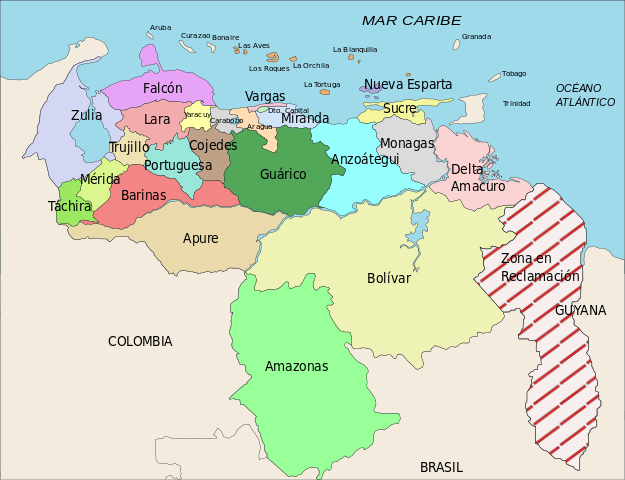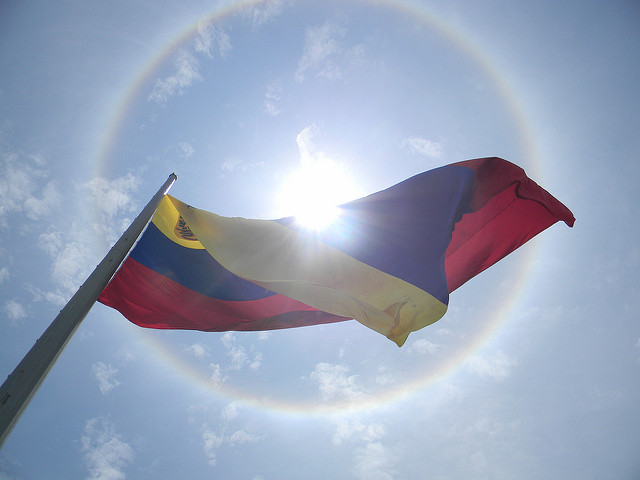5-Minute Guide to Venezuelan Spanish
Venezuela is a beautiful country famously known for its incredible beaches and amazing people. Yet, something not many people stop to think about is Venezuelan Spanish. This variety has many characteristics that make it unique. Let’s delve into the reality of this country and its Spanish dialect below!
A Quick Geography Lesson
Located in South America, Venezuela covers 882,050 square kilometres of mainland and it borders Guyana to the east, Brazil towards the south and Colombia to the west. It is Caribbean neighbours with Trinidad and Tobago, Barbados, Curaçao, Bonaire, Aruba, Saint Vincent, the Grenadines, and the Leeward Antille. Overall it’s the 33rd largest nation in the world.

Photo via Wikipedia
A Quick History Lesson
Originally Venezuela was first colonised by the Spanish in 1522, with many indigenous peoples such as the Mariches, Teques and others suffering greatly, despite many of their thwarted uprisings. Simón Bolívar, known as the Liberator, helped to win the Battle of Carabobo on 24th June 1821, thereby helping Venezuela to regain its own sovereignty. Venezuela subsequently became independent from Spain in 1830. Once famed for its petroleum exports and passion for baseball, lamentably it is now deeply marred by political wranglings, economic instability, mass hunger and criminality. In context, the IMF has predicted that inflation could reach a record 720% this year, with many people queueing long hours daily for basic necessities. Alas, the list could go on and one can only wish its people well. However, one of the defining features of what unites Venezuela is how the language is spoken and how distinct it is compared with much of South America.
Now onto the Linguistics of Venezuelan Spanish
In terms of language, due to its previous Spanish colonisation, the official and most widely spoken language is Spanish. But, if you’ve even so much as tried to communicate with a Venezuelan, you’ve probably already realised that Venezuelan Spanish is quite unique, and that’s exactly what we’re here to discuss.
First and foremost, let’s start with the basics. It’s customary for many words to be phonetically truncated, or words that become verbally shortened. Once Venezuelans become enthused on a particular topic then their speech can gain momentum rapidly, with the words once again becoming compressed to allow for a melodic tone. “Se comen las palabras” is what they’ll often tell you in relation to this social phenomenon. Quite literally “they eat their words”, or to any Anglo-speaker, the letters are dropped.
The most pertinent example of this is for the term para (for/ in order to) being dropped to “pa“, which is a frequent occurrence. Similarly, it is also highly frequent to hear several vowels being dropped during common speech. The most common case would be the S and D. Instead of ordering an Ice cream by saying helado in Venezuela, it’s far more common to say “helao“. Or when it comes to the S, the term for “many” in Spanish is muchos. Nevertheless, this is not aspirated, rather it sounds much softer, akin to the sound H to much-ohh. This particular aspect though does fall in line with several other dialects around the Caribbean and South America and coincidentally tends to happen whenever there is a beach.
Ah, the Suffixes
Another example of what distinguishes Venezuelan Spanish would be the use of the diminutive, which is extremely common. In short, it means ‘little, smaller or tiny’ in a particular sentence. Many words will have “ito/ita” added at the end of their word. This is a way of being more affectionate, spontaneous and playful with the language, in addition to making it somewhat more colloquial. For example ahora, the term for ‘now’ in Spanish, is commonly used as ahorita.
Occasionally, you can even see it on the ends of verbs like acabar, as in acabadito de llegar implying that someone has just barely arrived. Overall, this allows for a more idiomatic style of speech, carrying more sentiment by joyfully enjoying the language.
Who, me? No, you!
Moreover, the use of “you”, which is either “tú”, “vos” or “usted” in Spanish, is something that changes in each area. The most prevalent place to hear is the use of “vos” instead of “tú” in informal parlance is in Zulia.
Take into consideration that this construction in Venezuelan Spanish varies significantly compared with Rioplatense (Argentina and Uruguay). In place of tú eres, tú estás, those from Zulian say vos sois, vos estáis. This is similar to the plural forms used in Iberian Spanish such as vosotros sois, vosotros estáis; and different from the Rioplatense forms which are vos sos, vos estás etc.
In addition, towards the frontier with Colombia in such areas as Mérida, Táchira and Trujillo, both usted and tú are used in an interchangeable manner, regardless of whether it is a formal situation or not. It’s simply customary. Ustedes is also the correct plural address for you, throughout the whole of Venezuela and Latin America.
But Venezuelans Still Don’t All Sound the Same
There are also significant considerations to bear in mind when it comes to the accents of Venezuelan Spanish. The Margaritan dialect (oriental), originating in Isla Margarita and the northeast of mainland Venezuela, sees a strong use of ‘r’ instead of ‘l’ in most words. For example, instead of el mar, meaning the sea, it would be pronounced locally as “er mar“. Overall, the Caracas dialect, which is spoken in the capital, is used by the media and is taken to be the standard-bearer of Spanish in Venezuela, with its variants generally related to the social classes there. This is whether you’re a farándulero/a (nouveau riche) category or simply are a barriotero/a (somebody from a working-class neighbourhood).
Once again in comparison with Latin America, there is also no phonetic sound difference around the “seseo” in Venezuelan Spanish. In brief, this means there is no phonetic change between caza (hunt) and also casa (home), i.e. the S and Z sound the same. They cannot be distinguished unlike in Iberian Spanish, where the social development exists to allow the auditor to distinguish between the S and Z in a clear manner.

Photo via Flickr
Let’s Bring It All into Focus
Overall Venezuela is a diverse and multifaceted country, possessing differing ethnicities, each with its own customs and traditions, which is very much reflected in the language. Moreover, the country’s placement and orientation towards the Caribbean has meant that the language has evolved distinctly to much of the Spanish in South America.
Spanish in Venezuela is far more similar to that of Central America and Caribbean Spanish. Historically Iberian Spanish has helped mould Venezuelan Spanish, in addition to Spanish from the Canary Isles, which in turn was also influenced by African Languages. Furthermore, it is not so uncommon to find how Spanish in Venezuela has been altered by other languages such as Italian, French and English too.
Ultimately, Venezuelans are very warm, endearing and will be will very happy to ingratiate you into their social circles. In order to forge closer relations, it is probably best to be armed with some Venezuelan Spanish knowledge beforehand. Therefore, here are few terms to add to your lexicon!
- Arrecho(a) = adj. Superlative attribute for an object or situation, namely extremely good, bad or difficult (profane). Be aware, do not use this term with Colombians, as it means to arouse sexually.
- Burda = adv. or adj. (superlative) Very much or too much.
- Chamo(a) = n. Boy/girl. with the diminutive, ito/ita it can mean son or daughter. It’s akin to dude in US English or Lad in British English.
- Chévere = adj. Fine, cool. Keep this word in your back pocket as a filler for any situation, very hand indeed.
- Chimbo(a) = adj. Crooked, fake, poor quality, not in vogue.
- Enratonado = adj. To be hungover or drunk the day after the party
- Ladilla = adj. or n. Something or something which causes annoyance. It literally means a louse.
- Guayabo =n. To be romantically disillusioned or heartbroken. Lit. Tree of the guava fruit.
- Jamón = n. A French kiss.
- Marico/a = n. Commonly used friends. It’s common to hear although bear in mind only with close friends (profane/pejorative). Lit. Homosexual person (slur).
- Palo = n. Alcoholic beverage. Lit. Stick. Example: “¡Tómate un palito, pues!” = Have a little drink (then)!
- Pana = n. Akin to Friend, buddy, dude.
- Pipi Frío = exp. (or Pipe Frío) Someone that has been single or hasn’t engaged in sexual activities for a while. It may also be appropriated to someone lacking social skills or uninteresting. Lit. “Cold Penis”.
- Rumba = n. A party. Also used as a verb: Rumbear.
- Queso = n. Sexual drive, Lust. Mostly applied to men. Lit. Cheese. Example: “Tengo queso” = I’m horny.
- Verga = Dick (profane). Used to convey a feeling of shock, disgust or alert (profane).
- Zanahoria = n. Someone who zealously takes care of his/her own health. A vegetarian would be a prime example. A person that behaves well, nerd. Straight, clean. adj. A boring, dull person. Lit. Carrot.
If you’d like to learn Venezuelan Spanish or any other dialect of this language, check out our Free Trial Spanish Classes! We’ll match you with a qualified native-speaking teacher who will prepare a course tailored to your specific needs and adapted to fit your schedule. Get started on your way to Venezuelan Spanish fluency!
Article updated on September 17, 2021.
